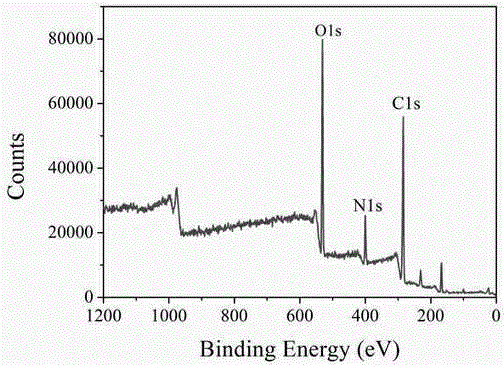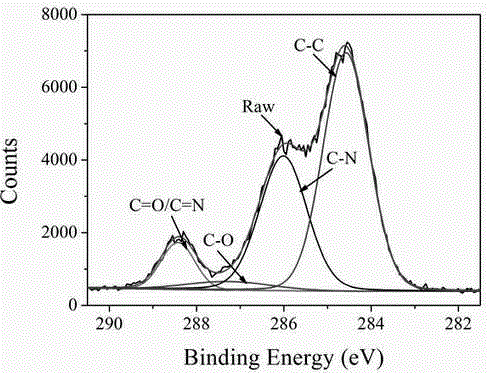One-step method for green synthesis of nitrogen-doped fluorescent carbon nanodots
A carbon nanodot, green synthesis technology, applied in the synthesis field of fluorescent nanomaterials, can solve the problems of limited industrial production, low quantum yield, etc., and achieve the effects of less raw material consumption, simple operation, and low comprehensive cost.
- Summary
- Abstract
- Description
- Claims
- Application Information
AI Technical Summary
Problems solved by technology
Method used
Image
Examples
Embodiment 1
[0013] Weigh 0.5g of maleic acid and dissolve in 10mL of distilled water, measure 0.3mL of ethylenediamine and add it to the above solution, and ultrasonically dissolve it evenly to obtain a colorless and transparent solution; then transfer the colorless and transparent solution to a hydrothermal reaction kettle Heating at 180°C for 3h, 6h, 9h, 12h, 15h, 18h and 21h respectively, and naturally cooling to room temperature to obtain 7 parts of tan solutions with colors ranging from light to dark, which were filtered with a filter membrane with a pore size of 0.1 μm, and the resulting nitrogen-doped The carbon nanodot solution was fixed in a 1000mL volumetric flask. The fluorescence intensity of the solution was measured on a fluorescence spectrophotometer (FP-6500 fluorescence spectrometer, Japan JASCO.CORERATION company), as shown in Table 1.
[0014] Table 1 Effects of different heating times on the synthesis of nitrogen-doped fluorescent carbon nanodots
[0015] Hy...
Embodiment 2
[0018] Weigh 0.5g of maleic acid and dissolve in 10mL of distilled water, successively measure 0mL, 0.1mL, 0.2mL, 0.25mL, 0.3mL, 0.4mL, 0.5mL and 1.0mL of ethylenediamine into the above solution, ultrasonically It dissolves uniformly to obtain a colorless and transparent solution; then transfer the colorless and transparent solution to a hydrothermal reaction kettle, heat at 180°C for 15 hours, and naturally cool to room temperature to obtain 8 parts of tan solutions with a color from light to dark, using a pore size of 0.1 μm filter membrane, and the resulting nitrogen-doped carbon nanodot solution was constant volume in a 1000mL volumetric flask. The fluorescence intensity of the solution was measured on a fluorescence spectrophotometer (FP-6500 fluorescence spectrometer, Japan JASCO.CORERATION company), as shown in Table 2.
[0019] Table 2 Effect of the amount of ethylenediamine on the synthesis of nitrogen-doped fluorescent carbon nanodots
[0020] Ethylenediam...
Embodiment 3
[0023] Weigh 0.5g of maleic acid and dissolve in 10mL of distilled water, measure 0.25mL of ethylenediamine and add it to the above solution, and ultrasonically dissolve it evenly to obtain a colorless and transparent solution; then transfer the colorless and transparent solution to a hydrothermal reaction kettle Heated at 130°C, 150°C, 170°C, 180°C, 190°C and 200°C for 15 hours in sequence, and naturally cooled to room temperature to obtain 6 parts of tan solutions with colors ranging from light to dark, and filtered them with a filter membrane with a pore size of 0.1 μm. The obtained nitrogen-doped carbon nano-dot solution was fixed in a 1000mL volumetric flask. The fluorescence intensity of the solution was measured on a fluorescence spectrophotometer (FP-6500 fluorescence spectrometer, Japan JASCO.CORERATION company), as shown in Table 3.
[0024] Table 3 Effect of hydrothermal reaction temperature on the synthesis of nitrogen-doped fluorescent carbon nanodots
[0025] ...
PUM
| Property | Measurement | Unit |
|---|---|---|
| size | aaaaa | aaaaa |
Abstract
Description
Claims
Application Information
 Login to View More
Login to View More - R&D Engineer
- R&D Manager
- IP Professional
- Industry Leading Data Capabilities
- Powerful AI technology
- Patent DNA Extraction
Browse by: Latest US Patents, China's latest patents, Technical Efficacy Thesaurus, Application Domain, Technology Topic, Popular Technical Reports.
© 2024 PatSnap. All rights reserved.Legal|Privacy policy|Modern Slavery Act Transparency Statement|Sitemap|About US| Contact US: help@patsnap.com










